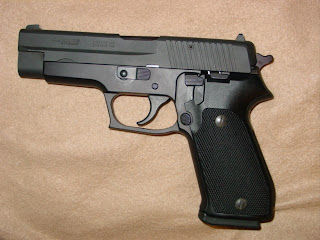Classic gun review: German SIG Sauer P220
Some years ago, back in the nineties, I went into town with the intention of buying a Colt Commander .45. I came home instead with a German made SIG Sauer P220 in the same caliber, and it has turned out to be a truly outstanding sidearm.
It did not look to me like a great pistol. The dull black finish and utilitarian plastic grips were plain and even homely alongside Colt's blue and walnut splendor. The SIG also looked rather square and blocky. I looked at the plain jane imported pistol, sitting there in the counter, then at its hefty price tag, and wondered what was going on. How could they charge that much for an ugly gun?
 |
| Doesn't look like much. Appearances can be deceiving. |
At the range, I found the SIG to be very accurate, and the fixed sights so close to being perfectly regulated with 230 grain bullets as to make no difference. Because the sights did not need monkeying with, I put away my brass drift and my file. Apart from one failure to eject in the first box of ammunition, the gun proved reliable as well, feeding any bullet weight or shape I tried and flinging the empties against the side of the stall.
The slide is pressed out of heavy steel sheet and a milled and drilled breech block is pinned into the stamping. That is engineering genius. It limits the machining to the place where it is really needed. Time is money on a production line, and if most of the slide is formed in one "Ah-woomph" of a big pressing machine, you're ahead on time. The frame is aluminum.
Current production SIG Sauers have their slides machined from bar stock. I think this is most likely due to the versatile and cost effective CNC machines available in the present day. It may also have something to do with customer acceptance; the former method was a departure from common practice, though an ingenious one.
The 220's development began with a Swiss military requirement to replace their SIG P210 9mm service pistol with something more modern and cost effective. The SIG 210 is a grand pistol but it is old school. It is finely machined, elegantly designed, and very expensive to produce. It requires a lot of machining time to turn one out. It's the Swiss watch of the pistol world. The idea was, the Swiss wanted something that shot as well and cost somewhat less. The result was a robustly built single stack 9mm, the original 220. The designers gave the new gun a generous action throw and a largish grip frame, so that it could be chambered for longer cartridges, such as the .45 ACP and the .38 Super.
Browning, for a while, imported the P220 in .45 ACP, marketing it as the "Browning Double Action .45," or BDA for short. These guns have the heel magazine release. The quality of these Browning SIG's is first rate.
 |
| Lock back the slide and turn the takedown lever downward |
 |
| Now the slide will run forward off the frame |
Field stripping is very easy. Lock the slide to the rear with the slide catch. Rotate the takedown lever downward until it stops. Holding onto the slide, release the slide catch. The slide, barrel, recoil spring and recoil spring guide come forward off the frame as a unit. Push forward on the guide rod to release it from the barrel lug. The spring, guide rod and barrel can now be lifted out of the slide. Reassembly is in reverse order.
 |
| It's easy to take apart. More importantly, it's easy to put back together. |
The SIG Sauer's system of operation, double action transitioning to single action, and no safety catch, has several advantages. A gun that works this way is as safe to carry as a double action revolver and as simple and quick to get into action. It gives you a very good single action pull for your follow-up shots, and for the first shot if you cock the pistol with your thumb. The SIG also gives you the ability to take a second whack at a bad primer, just by pulling the trigger again. It is endlessly debatable which design is best, this gun's, the Glock's or some other, but it must be allowed that this one is very good. The SIG Sauer pistols are safe, accurate, dependable, easy to clean and simple to use, thus they well deserve their place as some of the leading pistols of our times. But they're not as nice looking as a highly polished Colt.


I bought a German made p220 several years ago at a place to shoot in San Antonio Texas. It is still one of my favorite pistols! I have since bought several other p220's. Including the p220 10Mm. SIG P220'S RULE!!!
ReplyDelete